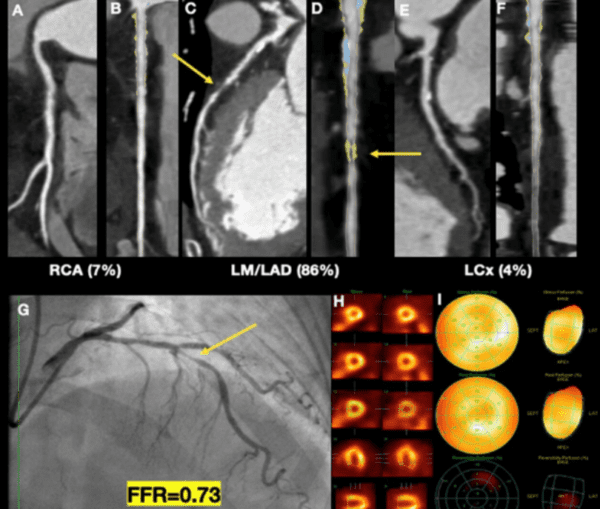|
Cleerly’s Downstream Effect | Internist POCUS
April 24, 2022
|
|
|

|
|
Together with
|

|
|
|
“If you want to deliver real clinical value, you shouldn’t only put AI as an end goal, but use AI within a thought-through workflow for radiologists.”
|
|
Arterys’ Maya Khalifé, PhD on one of the many lessons from the early days of AI.
|
|
|
I’m very happy to share the latest Imaging Wire Show featuring Arterys’ Maya Khalifé, PhD.
Check out this great discussion about delivering clinical value amid AI hype, Arterys’ platform approach to neuro AI, and how AI can serve radiologists today and into the future.
|
|

|
|
A new AJR study showed that Cleerly’s coronary CTA AI solution detects obstructive coronary artery disease (CAD) more accurately than myocardial perfusion imaging (MPI), and could substantially reduce unnecessary invasive angiographies.
The researchers used Cleerly to analyze Coronary CTAs from 301 patients with stable myocardial ischemia symptoms who also received stress MPI exams. They then compared these Cleerly CCTA and MPI results with the patients’ invasive angiography exams, and quantitative coronary angiography (QCA) and fractional flow reserve (FFR) measurements.
The Cleerly-based coronary CTA results significantly outperformed MPI for predicting stenosis and caught cases that MPI-based ischemia results didn’t flag:
- Cleerly AI detected more patients with obstructive stenosis (≥50%; 0.88 vs. 0.66 AUCs)
- Cleerly AI identified more patients with severe stenosis (≥70%; 0.92 vs. 0.81 AUCs)
- Cleerly AI detected far more patients with signs of ischemia in FFR (<0.80; 0.90 vs. 0.71 AUCs)
- Out of 102 patients with negative MPI ischemia results, Cleerly identified 55 patients with obstructive stenosis and 20 with severe stenosis (54% & 20%)
- Out of 199 patients with positive MPI ischemia results, Cleerly identified 46 patients with non-obstructive stenosis (23%)
MPI and Cleerly-based CCTA analysis also worked well together. The combination of ≥50% stenosis via Cleerly and ischemia in MPI achieved 95% sensitivity and 63% specificity for detecting serious stenosis (vs. 74% & 43% using QCA measurements).
Based on those results, pathways that use a Cleerly AI-based CCTA benchmark of ≥70% stenosis to approve patients for invasive angiography would reduce invasive angiography utilization by 39%. Meanwhile, workflows requiring a positive MPI ischemia result and CCTA Cleerly AI benchmark of ≥70% would reduce invasive angiography utilization by 49%.
The Takeaway
We’re seeing strong research and policy momentum towards using coronary CTA as the primary CAD diagnosis method and reducing reliance on invasive angiography. This and other recent studies suggest that CCTA AI solutions like Cleerly could play a major role in that CCTA-first shift.
|




|
|
Photon-Counting CT Breakthroughs
Clinicians are using the NAEOTOM Alpha to overcome limitations previously thought unavoidable in CT, with ultra-high spatial resolution without dose penalty and detailed spectral imaging without compromises. Get the facts about the technology and the benefits of photon-counting CT.
|
|
Leveraging the Power of Enterprise Imaging
Tune in to this value-packed Intelerad video to see imaging and clinical leaders discuss how they leverage the power of enterprise imaging.
|
|
- NPs Get NY FPA: New York became the 25th state to grant nurse practitioners Full Practice Authority, allowing them to perform the full scope of services that they are trained to provide, including ordering and interpreting diagnostic tests (potentially imaging). Like previous FPA rulings, NY politicians and nursing organizations highlighted how this change improves access to care, while physicians and their lobbies warned of patient safety risks and continued scope creep. FPA laws haven’t had a major impact on diagnostic radiology yet, but rads definitely don’t seem comfortable with this trend.
- Transpara’s Workload and False Positive Impact: A new study out of Denmark highlighted ScreenPoint Transpara’s potential to significantly reduce mammography screening workloads and avoid false positives. The researchers analyzed 114k exams using Transpara, finding that the AI system would have rivaled radiologists’ sensitivity and specificity (69.7% vs. 70.8%; 98.6% vs. 98.1%). Using Transpara’s risk scoring system to exclude normal exams from radiologist reading (<5 on 1-10 scale) would have reduced radiologist workloads by 62% and avoided 25% of false positive screenings. This study is one reason that Copenhagen adopted Transpara for its screening program.
- Lunit IPO Approved: Lunit’s IPO was officially approved by South Korea’s KOSDAQ exchange, paving the way for new R&D investments and its global expansion. Lunit’s forthcoming IPO follows several years of impressive VC fundraising (>$133M), achieving its first FDA approvals (CXR & mammography), and forming a notable list of global partnerships (GE, Philips, Fujifilm, INFINITT).
- Internist POCUS Assessments: A new Ultrasound Journal study provided rare insights into point-of-care ultrasound assessment quality when performed by internists, rather than sonographers or radiologists. Analysis of 169 POCUS exams performed by internists at a Netherlands medical center found that reporting completeness was “high, but not optimal,” with the clinical indication/question stated in 75.7% of cases, labels on 83.5% of saved images, and written conclusions in 90.8% of exams. The study revealed notable challenges with capturing all standard views for certain indications, particularly with heart, lung, and kidney exams (26.9%, 17.9%, 7.7% complete).
- Health System Challenges: A recent Advis survey of 75 health system executives revealed that staffing shortages and rising costs remain their greatest challenges. Over 90% of the executives said they’ve increased compensation to help recruit staff, while 81% reported that they are filling labor gaps with outside agencies. The need for more relief funds was apparent in the results, with 70% of the execs continuing to seek federal assistance to help offset their heightened expenses.
- Siemens Expands Brain MR AI: Siemens Healthineers expanded its homegrown AI portfolio, achieving FDA clearance for its AI-Rad Companion Brain MR (VA40A) solution, which supports segmentation and quantification of white matter hyperintensities in the brain. The clearance adds to AI-Rad Companion Brain MR’s capabilities, joining previously-cleared capabilities for Morphometry Analysis.
- Hyperfine’s AIS Validation: A new study out of Yale found that Hyperfine’s portable low-field Swoop MRI produces clinically useful bedside stroke imaging, “setting the stage for use in resource-limited environments.” The researchers used the Swoop MRI to examine 50 patients with confirmed ischemic stroke, detecting infarcts in 45 of the patients (90%), and producing stroke volume measurements that were consistent with conventional high-field MRI. The five patients without infarcs in their Swoop exams had small foci of restricted diffusion (4 to 10 mm) that were captured only by high-field MRI DWI sequences.
- Canon’s MR and US Rollout: Canon Medical’s two biggest modality debuts from RSNA 2021 are now available stateside, after the OEM officially released the Vantage Fortian 1.5T open bore MRI and the Aplio i-series / Prism Edition premium ultrasounds in the US. The Vantage Fortian launches with a range of productivity enhancements (patient monitoring /positioning tools, liver/prostate planning tools, and whole spine imaging) and supports Canon’s AiCE DLIR technology. The Aplio i-series / Prism Edition systems feature a new interface and ergonomics, higher processing power, new image enhancement applications (microvascular, ultra-wide view), and new AI-based workflow automations.
- 68Ga-PSMA-11 PET/CT for PCa Bone Metastases: A new AJR study showed that 68Ga-PSMA-11 PET/CT is far superior to 99mTc-MDP BS for detecting prostate cancer bone metastases. In the meta-analysis of 6 studies (n = 546 patients, 47 w/ bone metastases), 68Ga-PSMA-11 PET/CT had far higher sensitivity and specificity than 99mTc-MDP (98% vs. 83%; 97% vs. 68%), and detected bone metastases in 23% of patients who had negative 99mTc-MDP results. Meanwhile, 99mTc-MDP detected bone metastases in just 1.9% of patients with negative 68Ga-PSMA-11 PET/CT results.
- Vuno & Mayo’s Precision Partnership: South Korean AI company Vuno is partnering with Mayo Clinic to jointly develop and evaluate AI-based cancer biomarkers, leveraging Vuno’s AI tech and Mayo Clinic’s team and data (radiology, histopathology, and genomic data). Vuno and Mayo Clinic will initially focus on AI approaches to locate primary cancers, predict cancer recurrence, and predict treatment response.
- Siemens’ ICH AI Scores: A Siemens Healthineers-led study detailed an AI model that accurately detected, located, and subtyped intracranial hemorrhage in non-contrast head CTs, while providing confidence scores to support prioritization. The researchers trained the DL model with 26k CTs (+ 400 for external calibration), and tested against a 2,947-CT internal set and 16,764 external CTs, finding that it detected ICH with 0.97 and 0.95 respective AUCs. The model’s two confidence scores (CC & DC, both 0-1 scale), were 0.93/0.92 with the internal data and 0.88/0.89 with the external set, which would have improved reporting turnaround times by 25% to 27%.
|
|
How Thomas Jefferson Leveraged CARPL.ai
See how Thomas Jefferson University relied on CARPL.ai to accelerate its AI validation and clinical adoption in this presentation by informatics and AI leader, Dr. Paras Lakhani.
|
|
- Join this interactive webinar by Fairfax Radiological Consultants’ Dr. Melany Atkins, detailing how AI and 4D Flow supports cardiac imaging.
- Women’s imaging has come a long way, but operational efficiency remains a challenge for many facilities. To help address this challenge, this Fujifilm post details the five questions women’s imaging facilities should ask when evaluating workflow management solutions.
- In this Nuance Q&A, Open System Imaging’s medical director and CTO discuss how adopting PowerScribe One improved the California radiology practice’s efficiency and productivity.
- Midwest Radiology Outpatient Imaging of St. Paul, Minnesota recently became the proud owner of United Imaging’s uMI 550, giving its team and patients a PET/CT system that combines clinical flexibility with digital technology that prevents obsolescence.
- PACS efficiency and accuracy can have a major impact on radiologist workflows, but these qualities aren’t guaranteed. Check out this Novarad report detailing how to improve your PACS efficiency and accuracy.
- Considering your short and long-term AI plan? Check out Canon Medical’s State of AI Roundtable, sharing insights into how imaging AI is being used, where it’s needed most, and how AI might assume a core role in medical imaging.
- Check out this Change Healthcare video explaining the difference between single-tenant and multitenant cloud architecture, and how multitenant solutions can improve your efficiency and flexibility.
- The USPSTF guidelines for lung cancer screening were updated in May 2021, and driving compliance to such guidelines is a long, slow, repetitive process. Because of that, the Riverain team put together a kit to help hospitals and imaging centers educate either referring physicians or patients on the new guidelines either via branded tools or through the media.
- Arterys’ Cardio AI solution just added a new Atrial Volumes feature, allows cardiologists and radiologists to easily quantify volumes for both left and right atria in cardiac MRI images.
- See how Einstein Healthcare Network reduced its syringe expenses, enhanced its syringe loading, and improved its contrast documentation when it upgraded to Bayer Radiology’s MEDRAD Stellant FLEX CT Injection System.
|
|
|
|
|